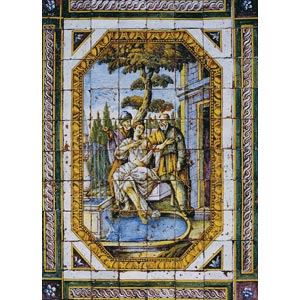
- Home
- Online auctions
-
Ended auctions
- Coins & Medals
- Philately
- Antiquities
- Old Masters
- Jewellery, Silver, Watches
- Ancient and Modern Glyptic
- Ceramics
- Antiques
- Modern & Contemporary Art
- 20th Century Design and Decorative Arts
- Prints and Multiples
- Asian and Tribal Art
- Photography
- Medieval Art
- Ancient Frames
- Fashion, Textiles & Luxury
- Books, Autographs and Memorabilia
- Wines and spirits
- Oddities, Curiosities & Wonders
- Info
- Live Auction
- Home
- Auction 32
- 65 Floor mosaic consisting of square majolica terracotta ...
Lot 65 - Auction 32
Description
NAPLES. Produced by a local workshop to a model in the style of Vanvitelli. Central figuration painted by Berardino Gentili. Overall decorative pattern by anonymous workshop decorators; 1740s–50s.Majolica of considerable thickness and excellent quality, white-grey in colour, painted in polychrome in shades of light and dark manganese violet, olive green, bright and dark yellow, and pale sky blue.
Tiles: square; to the number of 1,298; 21.5 cm square; <2.2 cm.>.
Current size of the mosaic: rectangle measuring 11.85 x 5.30 mt; covered surface: 62.50 sq. mt. Condition: excellent. Thermoluminescence: Bari, Centro studi di Radioattività e Radioecologia, prot. n. 112CSRR/94, dated 20/01/1994:
1747–57
Bibliography: Gardelli 1994, pp. 26 – 31.
At the heart of the complex figuration on this splendid 18th century floor we find the Bible story of Susanna and the Elders. The condition of the majolica surface, which shows no sign of ever having been trodden upon, suggests that the mosaic was intended for a large basin in a garden, a fashionable feature in the huge parks of 18th century villas. The central subject, showing a young girl on the point of bathing, also appears to bear out this contention, which is further endorsed by a series of clues such as the tiles missing where the water would have emerged and the decision to darken the white bottom, probably in order to soften the sun's reflection which would have been too dazzling on the water.
The overall decorative scheme points to the design of an expert architect au fait with the latest developments in Mittel European art. The composition reveals an extremely elegant rationalism typical of the cultural climate of the Enlightenment.
The type of clay used for the tiles, their dimensions, the glaze and the tonality of the palette all point to a Neapolitan workshop of the 18th century, and that date is confirmed by thermoluminescence which has assigned the mosaic to the decade stretching from 1747 to 1757.
The architect who designed and drew the structure of the floor and the artist who painted the central picture have yet to be identified for certain. In fact at least two painters were involved, one painting the actual picture and another, more anonymous hand responsible for the decoration.
The scene of Susanna bathing, based on a celebrated engraving by Annibale Carracci (1593–5) replicated by Jean Mariette in the 17th century, is found also in numerous ceramic figurations, in particular in those produced by the workshop in Castelli, a town which belonged to the Kingdom of Naples (Gardelli 2012, p.2 6). The palette is brighter than in the rest of the decoration, and the girl's facial features and pose recall the style of the Gentili workshop.
Underlying the floor's entire figuration, on the other hand, there is a design echoing the style of the architect Luigi Vanvitelli (1700–73) whom Charles de Bourbon (King Charles the VII of Naples, V of Sicily and, eventually, III of Spain) called to the court of Naples to build the splendid royal residence known as the Reggia of Caserta.
Please use the registration form to send us your participation request, or, if you are already registered and authorized, use the login box on the top.
For any information please contact info@bertolamifineart.com
 Respecting your privacy is our priority
Respecting your privacy is our priority
This site uses cookies to improve user experience and to collect information on the use of the site. There are also cookies that can be used for the selection of personalized advertisements and promotional content. You can read our cookie policy, accept all cookies and continue browsing by clicking on "Accept" or customize your choice by clicking on "Customize".
Cookie Policy
Cookies
To make this site work properly, we sometimes install small data files called "cookies " on your device. Most of the big sites do the same.
What are cookies?
A cookie is a small text file that websites save on your computer or mobile device while you visit them. Thanks to cookies, the site remembers your actions and preferences (for example login, language, font size and other display settings) so that you do not have to re-enter them when you return to the site or browse from one page to another.
How do we use cookies?
Third party cookies
Google Analytics
This site uses Google Analytics to collect information about the use of users of its website. Google Analytics generates statistical and other information through cookies, stored on users' computers. The information generated relating to our website is used to make reports on the use of websites. Googl
How to control and modify cookies?
You can modify or withdraw your consent at any time from the cookie declaration on our website.
Privacy Policy
Find out more about who we are, how you can contact us and how we process personal data in our privacy policy .
The necessary cookies help to make the website usable by enabling basic functions such as page navigation and access to protected areas of the site. The website cannot function properly without these cookies.
| Name | Supplier | Purpose | Expiry |
|---|---|---|---|
| cookieConsent | Bid Inside | Stores the user's cookie consent status for the current domain | 6 months |
| PHPSESSID | Bid Inside | Preserve the user's status in the different pages of the site. | When the browsing session ends |
| f_display | Bid Inside | The f_display cookies memorize the display mode chosen by the user in the pages where there are lists | When the browsing session ends |
| f_page | Bid Inside | The f_page cookies store the page viewed by the user in the pages where there are lists | When the browsing session ends |
| f_rec_page | Bid Inside | The f_rec_page cookies store the number of elements to be displayed per page chosen by the user in the pages in which there are lists | When the browsing session ends |
| f_order_by | Bid Inside | The f_order_by cookies store the sorting parameter selected by the user in the pages where there are lists | When the browsing session ends |
| f_order_dir | Bid Inside | The f_order_dir cookies store the ordering direction chosen by the user in the pages where there are lists | When the browsing session ends |
| watch_list_show_imgs | Bid Inside | The watch_list_show_imgs cookie stores the user's choice to show or hide lot images on the watch list page | When the browsing session ends |
| selected_voice | Bid Inside | The selected_voice cookie stores the voice selected by the user for the speech synthesis present in the live auction | 1 Month |
| include_autobids | Bid Inside | The include_autobids cookie stores the user's choice to show or hide their auto-bids on the 'Your bids' page | 6 months |
Analytical cookies help to understand how visitors interact with the website, collecting and transmitting statistical information to the Data Controller.
| Name | Supplier | Purpose | Expiry |
|---|---|---|---|
| _ga | Register a unique ID used to generate statistical data on how the visitor uses the website. | 2 years | |
| _gat_gtag | Used by Google Analytics to limit the frequency of requests | 1 day | |
| _gat | Used by Google Analytics to limit the frequency of requests | 1 day | |
| _gid | Register a unique ID used to generate statistical data on how the visitor uses the website. | 1 day | |
| __utma | Bid Inside | Used to distinguish users and sessions. The cookie is created when the javascript library executes and no existing __utma cookies exists. The cookie is updated every time data is sent to Google Analytics. | 2 years |
| __utmt | Bid Inside | Used to throttle request rate. | 10 minutes |
| __utmb | Bid Inside | Used to determine new sessions/visits. The cookie is created when the javascript library executes and no existing __utmb cookies exists. The cookie is updated every time data is sent to Google Analytics. | 30 minutes |
| __utmc | Bid Inside | Not used in ga.js. Set for interoperability with urchin.js. Historically, this cookie operated in conjunction with the __utmb cookie to determine whether the user was in a new session/visit. | When the browsing session ends |
| __utmz | Bid Inside | Stores the traffic source or campaign that explains how the user reached your site. The cookie is created when the javascript library executes and is updated every time data is sent to Google Analytics. | 6 months |
| __utmv | Bid Inside | Used to store visitor-level custom variable data. This cookie is created when a developer uses the _setCustomVar method with a visitor level custom variable. This cookie was also used for the deprecated _setVar method. The cookie is updated every time data is sent to Google Analytics. | 2 years |
Preference technical cookies allow a website to remember information that affects the way the site behaves or presents itself, such as your preferred language or the region you are in.
We do not use cookies of this type.Profiling cookies are used for marketing purposes, to monitor website visitors. The intent is to display relevant and engaging ads for the individual user.
| Name | Supplier | Purpose | Expiry |
|---|---|---|---|
| _fbp | Facebook Pixel, targeting and advertising cookie. This cookie allows us to show our advertising to people who have already visited our website, when they are on Facebook or on a digital platform supported by Facebook Advertising. | 6 months | |
Unclassified cookies are cookies that are being classified, together with individual cookie providers.
We do not use cookies of this type.





 66
66